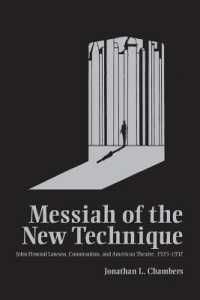Full Description
What was really going on at Roman banquets? In this lively new book, veteran Romanist Matthew Roller looks at a little-explored feature of Roman culture: dining posture. In ancient Rome, where dining was an indicator of social position as well as an extended social occasion, dining posture offered a telling window into the day-to-day lives of the city's inhabitants. This book investigates the meaning and importance of the three principal dining postures--reclining, sitting, and standing--in the period 200 B.C.-200 A.D. It explores the social values and distinctions associated with each of the postures and with the diners who assumed them. Roller shows that dining posture was entangled with a variety of pressing social issues, such as gender roles and relations, sexual values, rites of passage, and distinctions among the slave, freed, and freeborn conditions. Timely in light of the recent upsurge of interest in Roman dining, this book is equally concerned with the history of the body and of bodily practices in social contexts.
Roller gathers evidence for these practices and their associated values not only from elite literary texts, but also from subelite visual representations--specifically, funerary monuments from the city of Rome and wall paintings of dining scenes from Pompeii. Engagingly written, Dining Posture in Ancient Rome will appeal not only to the classics scholar, but also to anyone interested in how life was lived in the Eternal City.
Contents
List of Illustrations ix Acknowledgments xi Abbreviations xiii Introduction 1 Chapter One: Dining Men: Posture, Leisure, and Privilege 15 1. Overview 15 2. Reclining and Elite Otium: Some Literary Evidence 16 3. Reclining and Social Integration: Subelite Funerary Monuments 22 4. Reclining and Self-Reflection: Pompeian Mural Decoration 45 a. Casa del Fabbro (I.10.7) 49 b. Casa dei Casti Amanti (IX.12.6-7) 61 c. VI.16.36 69 d. Casa del Triclinio (V. 2.4) 70 e. Provisional Conclusions: Subelites and Self-Reflection 77 f. Grand Houses 80 5. Alternative Postures and the Rejection of Otium 84 6. Conclusion: The Popina 92 Chapter Two: Dining Women: Posture, Sex, and Status 96 1. Overview 96 2. Women's Dining Posture, Ideology and Practice: Literary Representations 98 a. Republican Period 99 b. Augustan Period 112 c. Imperial Period 118 3. Women's Dining Posture and Family Values: Subelite Funerary Monuments 123 4. Women's Dining Posture and Self-Reflection: Pompeian Mural Decoration 139 5. Conclusion: The Ideology and Practice of Women's Dining Posture 153 Chapter Three: Dining Children: Posture, Pedagogy, and Coming-of-Age 157 1. Overview 157 2. Sitting Children 159 3. Reclining Children 169 4. General Conclusions 175 Appendix: Convivial Wine Drinking and Comissationes 181 Catalogue of Funerary Monuments and Wall Paintings 189 Bibliography 197 Index Locorum 209 General Index 215








